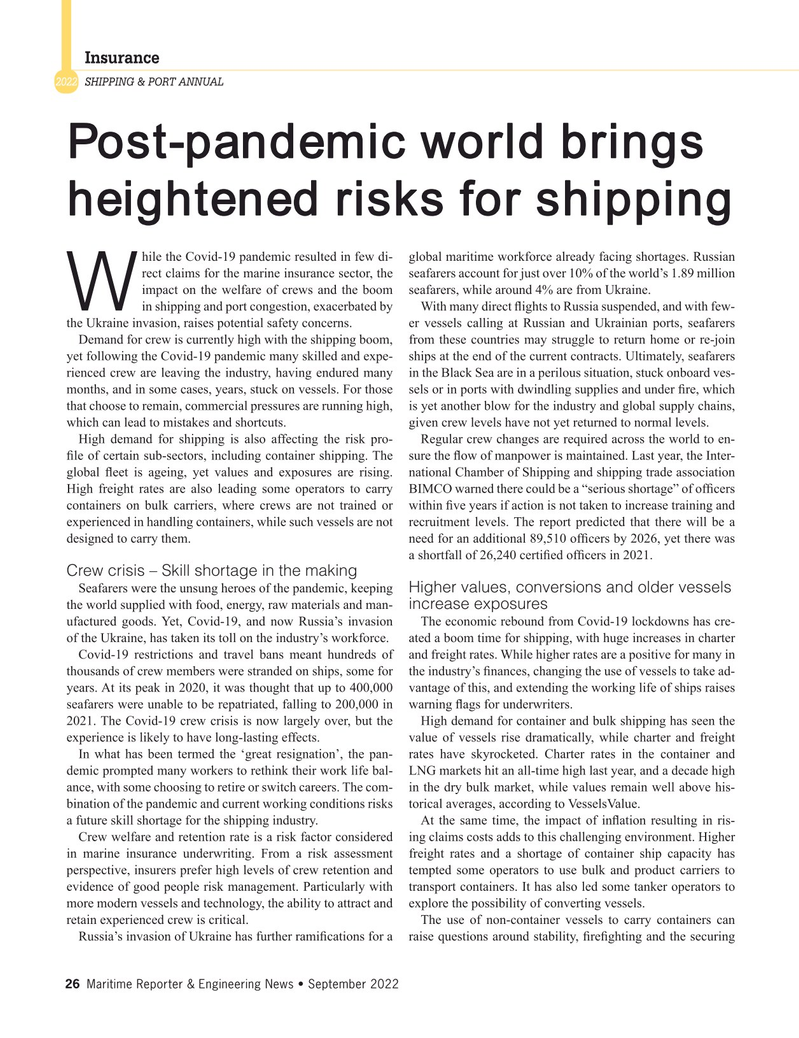
Page 26: of Maritime Reporter Magazine (September 2022)
The Marine Design Edition
Read this page in Pdf, Flash or Html5 edition of September 2022 Maritime Reporter Magazine
Insurance 2022 SHIPPING & PORT ANNUAL
Post-pandemic world brings heightened risks for shipping hile the Covid-19 pandemic resulted in few di- global maritime workforce already facing shortages. Russian rect claims for the marine insurance sector, the seafarers account for just over 10% of the world’s 1.89 million impact on the welfare of crews and the boom seafarers, while around 4% are from Ukraine.
W in shipping and port congestion, exacerbated by With many direct ? ights to Russia suspended, and with few- the Ukraine invasion, raises potential safety concerns. er vessels calling at Russian and Ukrainian ports, seafarers
Demand for crew is currently high with the shipping boom, from these countries may struggle to return home or re-join yet following the Covid-19 pandemic many skilled and expe- ships at the end of the current contracts. Ultimately, seafarers rienced crew are leaving the industry, having endured many in the Black Sea are in a perilous situation, stuck onboard ves- months, and in some cases, years, stuck on vessels. For those sels or in ports with dwindling supplies and under ? re, which that choose to remain, commercial pressures are running high, is yet another blow for the industry and global supply chains, which can lead to mistakes and shortcuts. given crew levels have not yet returned to normal levels.
High demand for shipping is also affecting the risk pro- Regular crew changes are required across the world to en- ? le of certain sub-sectors, including container shipping. The sure the ? ow of manpower is maintained. Last year, the Inter- global ? eet is ageing, yet values and exposures are rising. national Chamber of Shipping and shipping trade association
High freight rates are also leading some operators to carry BIMCO warned there could be a “serious shortage” of of? cers containers on bulk carriers, where crews are not trained or within ? ve years if action is not taken to increase training and experienced in handling containers, while such vessels are not recruitment levels. The report predicted that there will be a designed to carry them. need for an additional 89,510 of? cers by 2026, yet there was a shortfall of 26,240 certi? ed of? cers in 2021.
Crew crisis – Skill shortage in the making
Seafarers were the unsung heroes of the pandemic, keeping Higher values, conversions and older vessels the world supplied with food, energy, raw materials and man- increase exposures ufactured goods. Yet, Covid-19, and now Russia’s invasion The economic rebound from Covid-19 lockdowns has cre- of the Ukraine, has taken its toll on the industry’s workforce. ated a boom time for shipping, with huge increases in charter
Covid-19 restrictions and travel bans meant hundreds of and freight rates. While higher rates are a positive for many in thousands of crew members were stranded on ships, some for the industry’s ? nances, changing the use of vessels to take ad- years. At its peak in 2020, it was thought that up to 400,000 vantage of this, and extending the working life of ships raises seafarers were unable to be repatriated, falling to 200,000 in warning ? ags for underwriters.
2021. The Covid-19 crew crisis is now largely over, but the High demand for container and bulk shipping has seen the experience is likely to have long-lasting effects. value of vessels rise dramatically, while charter and freight
In what has been termed the ‘great resignation’, the pan- rates have skyrocketed. Charter rates in the container and demic prompted many workers to rethink their work life bal- LNG markets hit an all-time high last year, and a decade high ance, with some choosing to retire or switch careers. The com- in the dry bulk market, while values remain well above his- bination of the pandemic and current working conditions risks torical averages, according to VesselsValue.
a future skill shortage for the shipping industry. At the same time, the impact of in? ation resulting in ris-
Crew welfare and retention rate is a risk factor considered ing claims costs adds to this challenging environment. Higher in marine insurance underwriting. From a risk assessment freight rates and a shortage of container ship capacity has perspective, insurers prefer high levels of crew retention and tempted some operators to use bulk and product carriers to evidence of good people risk management. Particularly with transport containers. It has also led some tanker operators to more modern vessels and technology, the ability to attract and explore the possibility of converting vessels. retain experienced crew is critical. The use of non-container vessels to carry containers can
Russia’s invasion of Ukraine has further rami? cations for a raise questions around stability, ? re? ghting and the securing 26 Maritime Reporter & Engineering News • September 2022
MR #9 (18-33).indd 26 9/5/2022 9:46:18 AM

 25
25

 27
27
